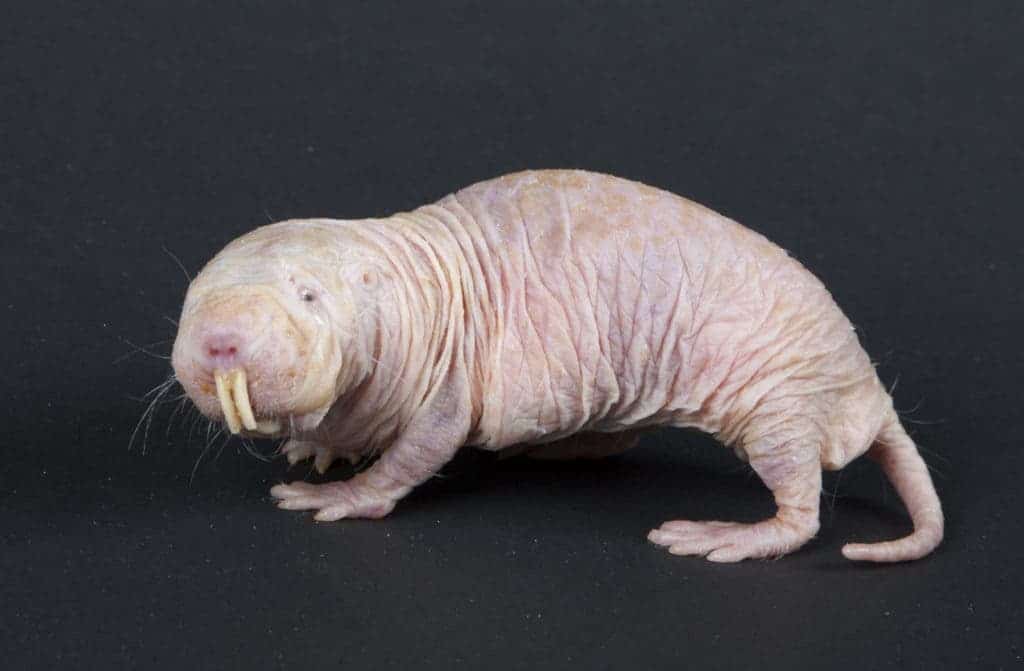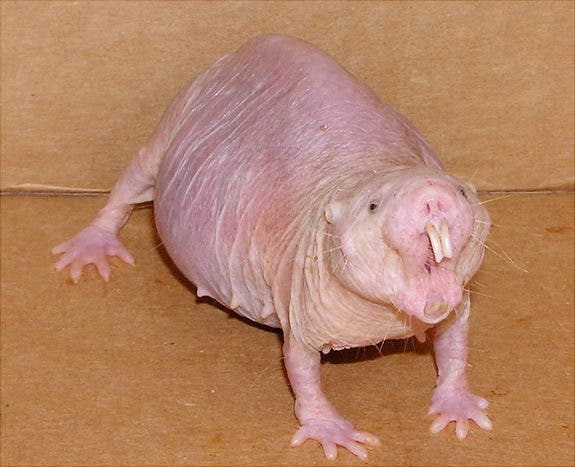
Although they might not be the prettiest mammals in the world, naked mole-rats (Heterocephalus galbe) are certainly among the most amazing. This burrowing rodent lives 10 times longer than it should, is impervious to pain and largely immune to cancer — among many other mind-boggling facts about these rodents. And beneath their wrinkly pink skin, these bizarre creatures may very well hold the secret to the elixir of life.
They completely lack hair or fur
As their name suggests, naked mole-rats completely lack hair or fur on their bodies. That’s almost unheard of for a mammal. But perhaps that shouldn’t come as a surprise. After all, such a special creature deserves a unique appearance.
Naked mole rats are native to East Africa, where they live underground inside very complex networks of tunnels. Several feet below the surface, the temperature never goes up or down, which is why they don’t really need any hair. All they have are some facial whiskers and a few specialized body hairs that help the mole-rats navigate their surroundings.
They’re the only cold-blooded mammals
In the absence of any environmental pressure to regulate their body temperatures, naked mole-rats evolved to be cold-blooded — it’s the only such mammal on the planet.
Naked mole-rat colonies are akin to bees, with a single breeding queen female
The way mole-rats mate and interact socially is closer to certain insect species than with mammals. Naked mole rats live in colonies that number up to 300 sterile individuals headed by a queen, who is the sole breeding female — yes, just like bees.
This behavior is known as eusociality. But unlike bees, which relay instructions among themselves through pheromones, the naked mole-rat queen uses physical violence and aggression to keep its subjects in line, who are tasked with digging tunnels, foraging, defending tunnel entrances, and even nannying the young. If the queen dies, any other unfertile female can be crowned. The regular working mole-rat is unfertile but can turn on the reproduction function if needed.
Their teeth have a dedicated part in the brain to manipulate objects

Like any other mole, the naked mole rat’s biggest asset is its teeth. Used for both digging and combat, the creature’s front incisors protrude outside its lips in order to bite through the soil as efficiently as possible while also avoiding a mouthful of earth during each dig. Meanwhile, the lower incisors are more dexterous, allowing the mole rate to manipulate objects. This skill is so important that they have a specialized sensory area in their brains dedicated to their teeth, just like humans have a dedicated space in the brain for processing hand movements.
Cancer resistance
The most amazing things about the naked mole-rat are not visible with the naked eye. One of their greatest gifts is a phenomenal resistance to cancer. There are very few documented cases of cancer in naked mole rats, and scientists hope to one day identify what protects them and transfer it to humans.
Some evidence suggests that the cells of mole rats have a different meshwork of substances providing structural and nutritional support, which doesn’t allow cancer cells to proliferate uncontrollably.
They’re impervious to some types of pain
Some humans can go into shock when they ingest capsaicin (the substance that makes chili peppers hot) but naked mole-rats don’t feel any pain when coming in contact with the substance. What’s more, when they encounter an acid, molecules in the creature’s pain-sensing nerves turn the acid into an anesthetic. So, rather than hurting them, a strong acid actually numbs the naked mole-rats.
Naked mole-rats still feel pain if they’re subjected to intense heat or pressure, just like us, but their abilities to neutralize certain chemicals that should normally cause pain is of great interest to scientists. For instance, there are a lot of people suffering from chronic pain related to acid build-up in their tissue due to various illnesses. A drug based on the mole-rats’ biology might do wonders.
They can survive up to five hours without oxygen
Used to living in packed close quarters with one another, and underground to boot, naked mole-rats have evolved to be highly resilient in low-oxygen conditions. Their oxygen use is so efficient that they can function for up to five hours without any oxygen whatsoever. Instead, when oxygen is low or non-existent, the mammals use fructose to power energy production in their cells.
Up to now, this metabolic pathway was only documented in plants — so finding it in the moles was a big surprise. They’re also seemingly immune to pulmonary edemas — the buildup of fluid which clogs the lungs of mammals in low-oxygen environments, such as climbers at high altitude.
This ability could someday be translated into a novel treatment for patients suffering crises of oxygen deprivation, as in heart attacks and strokes.
They live much longer than they should be able to

In most cases, there’s a direct link between body size and lifespan. Broadly speaking, the larger the body, the longer the lifespan, and this is especially true for mammals. Considering their body size, naked mole-rats might be expected to live 4-6 years. However, they can actually live up to 30 years in captivity.
Interestingly, the colony’s queen and king(s) (up to three males can be fertile in a colony) actually live longer than the sterile workers.
“Our results indicate that when naked mole-rats mature into breeders, it changes their aging rates, meaning that breeders are able to live longer than non-breeders. This is surprising, as evidence from other species suggest that reproduction, which ensures the survival of the species as a whole, reduces the lifespan of the individual. In naked mole-rats reproduction appears to prolong the breeders’ lifespan. This goes against the common expectation that mammals either invest resources in a long life or in reproduction,” said Dr. Martin Bens from the Leibniz Institute on Aging in Germany, who conducted research on naked mole-rat aging.
That’s not all. Rochelle Buffenstein, a comparative biologist who works for Google’s anti-aging company Calico, gathered data from over 3,000 naked mole-rat specimens from her lab and discovered that the Gompertz-Makeham law, a mathematical equation that relates aging to mortality, doesn’t apply to mole-rats.
According to this law, the risk of dying rises exponentially with age; in humans, for example, it doubles roughly every 8 years after the age of 30. This applies to most animals, especially to mammals, but apparently not to our rodent super-heroes. A naked mole-rat’s daily risk of dying is a little more than one in 10,000, even after reaching sexual maturity at 6 months, and stays the same throughout their lives, sometimes even decreasing.
“To me this is the most exciting data I’ve ever gotten,” Buffenstein said in a statement. “It goes against everything we know in terms of mammalian biology.”
What’s even more striking is that the burrowing rodents seem to age without any clear signs of degeneration and age-related health issues. For instance, the mole-rats’ blood vessels retain their elasticity, and the queens do not enter menopause and are still able to breed even at the age of thirty.
“Our research demonstrates that naked mole rats do not age in the same manner as other mammals, and in fact show little to no signs of ageing, and their risk of death does not increase even at 25 times past their time to reproductive maturity,” Buffenstein said.
“These findings reinforce our belief that naked mole rats are exceptional animals to study to further our understanding of the biological mechanisms of longevity.”
These are some of the most amazing facts about naked mole-rats. Many might laugh out loud at their comical appearance, but if there’s anything that we’ve learned today is that these rodents have incredible powers that might one day save many human lives.







